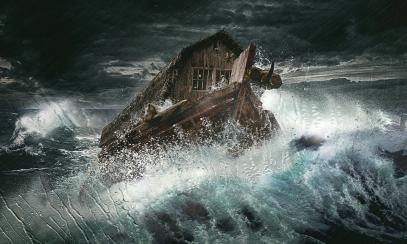The Hobbit and the Gospel
Like Star Wars, The Divine Comedy, and Moby Dick, J.R.R. Tolkien’s The Hobbit is the story of a hero’s journey. This helps to explain, of course, why, like those other narratives, it has proved so perennially compelling. The hero’s tale follows a classical, almost stereotyped, pattern: a person is wrenched out of complacency and self-absorption and called to a great adventure, during which he (or she), through struggle, comes to maturity and vision. In Moby Dick, the young Ishmael quits the narrow space of his depressed mind (“whenever it is a damp drizzly November in my soul”) and goes on a long and dangerous voyage of discovery; in The Divine Comedy, the middle-aged Dante leaves the dark wood where he had become lost and goes on a pilgrimage through Hell, Purgatory, and Heaven, until he comes at last to salvation; and in Star Wars, the teen-aged Luke Skywalker (who is modeled in many ways after Dante) is wrenched out of the quietude of his aunt and uncle’s home and summoned to an inter-galactic struggle against dark powers, which results in his coming of age.
The Hobbit begins, humbly enough, with this line: “in a hole in the ground there lived a hobbit.” Tolkien is quick to clarify that this is not a nasty or unkempt hole, like the lair of a mouse, but rather a cozy place, filled with fine furniture, doilies, and a well-stocked kitchen. This is the homey, all-too-comfortable space from which Bilbo Baggins (the hobbit in question) will be summoned to adventure. To the door of Bilbo’s residence comes Gandalf the wizard, a figure evocative of the in-breaking of grace. This association between the wizard and supernatural grace is not an arbitrary one, for Tolkien was a devout Catholic, and Christian themes abound in this particular hero’s story. Though he ardently resists it at first, Bilbo eventually accepts Gandalf’s invitation to join a cadre of dwarves on their mission to recover a horde of treasure that had been absconded by a dragon named Smaug. He will come to maturity precisely in the measure that he leaves his “comfort-zone” and finds the path of self-sacrificing love.
The mission is marked, at every turn, by danger. Bilbo and the dwarves confront hungry trolls, fiercesome orcs, wicked goblins, ferocious wolves, giant spiders, and eventually the mighty fire-breathing dragon himself. These fanciful characters signal the fact of serious evil at work in the world. Tokien was a participant in the trench warfare of the First World War and thus experienced, at first hand, cruelty, violence, injustice, depravity, and mind-numbing fear. His Christian faith gave him the conviction that all of this evil was the result of sin, at both the human and super-human level. It also helped him to see that the whole point of life was to enter into the lists against evil, to find one’s unique calling to battle wickedness and hence bring the world more into conformity with the reign of God. What is particularly instructive in The Hobbit is the manner in which a Christian knight properly engages in the battle. At a key moment in the story, Gandalf suggests that while many think darkness is best opposed through exercises of great worldly power, in point of fact, it is most effectively countered through simple acts of kindness. This is, of course, nothing but Jesus’ still deeply challenging teaching in the Sermon on the Mount that evil is properly resisted through love, non-violence, and forgiveness. The most striking example of this principle in action is Bilbo’s refusal to kill the loathsome and dangerous Gollum when he has the chance. As readers of The Lord of the Rings know, Gollum would, despite himself, play the decisive role in the destruction of the ring. Had Bilbo indulged his violent instincts and put Gollum to death, the day would not have been saved. That evil is best engaged through pity is a deeply Christian and profoundly counter-intuitive insight.
At the climax of The Hobbit, the adventurers come face to face with Smaug, the dragon who, deep in the bowels of a great mountain, guards a pile of treasure absconded from the dwarves many years before. The beast knows every little bit of his horde: each coin, each goblet, each jewel and precious stone. To be sure, he cannot possibly use or benefit from any of it, but he wallows in it and protects it with his life. Tolkien refers to this weird obsession as “the dragon sickness,” and he implies that it bedevils many people in contemporary society, those who know the value of everything and the worth of nothing. Nurtured by Catholic social teaching, Tolkien was no defender of laissez-faire capitalism or modern industrialism. In fact, he saw both as soul-killing, for the spirit thrives, not on gaining possessions, but on emptying out the self in love. This is why the killing of the dragon is such a moment of liberation. However, it is most important to observe how the sudden freeing up of the treasure awakens the dragon-sickness in hundreds of other creatures in Tolkien’s Middle Earth, who stream toward the mountain to claim Smaug’s trove. The battle of these rival claimants is held off (and I won’t give too much of the story away here) by an unexpected act of letting-go on Bilbo’s part, not unlike the letting-go of the ring at the conclusion of The Lord of the Rings. Once more, maturity comes, not from getting, but from giving.
A coming of age story, a rollicking adventure tale, a delicious fantasy, and a droll commentary on human foibles—The Hobbit is all that. But finally, it is a narrative spun by a serious Catholic who wants to communicate the still surprising ethics of the Gospel.
Father Robert Barron is the founder of the global ministry, Word on Fire, and the Rector/President of Mundelein Seminary. He is the creator of the documentary series, "Catholicism," airing on PBS stations, CatholicTV and EWTN. The documentary has been awarded an esteemed Christopher for excellence. Learn more about the series at www.WordonFire.org



